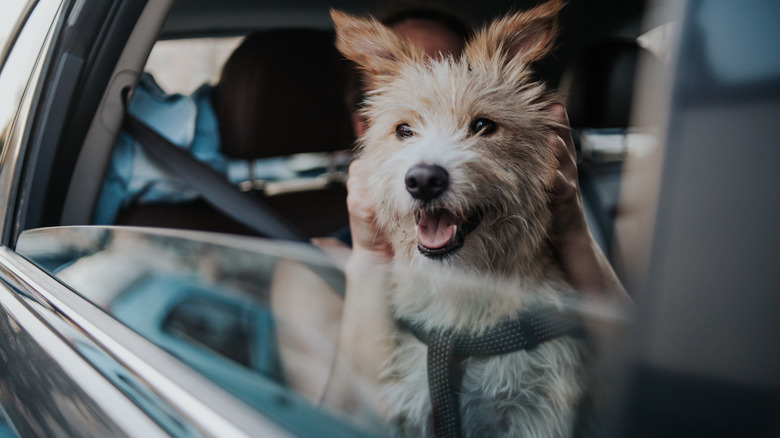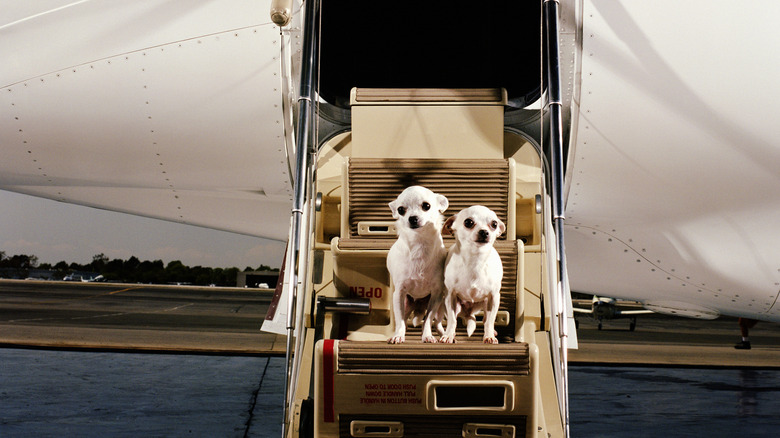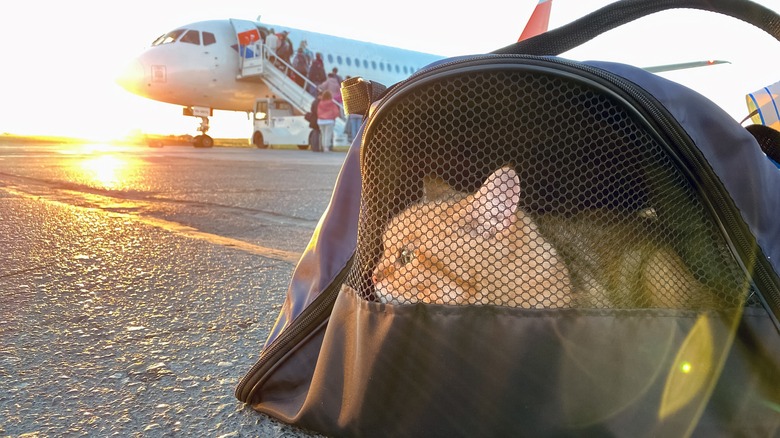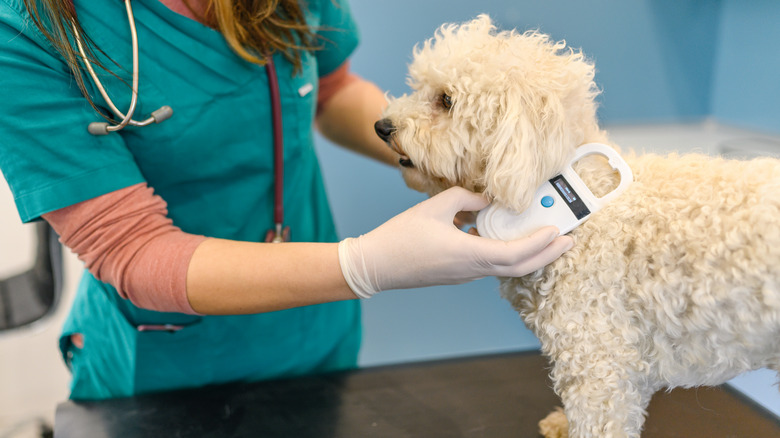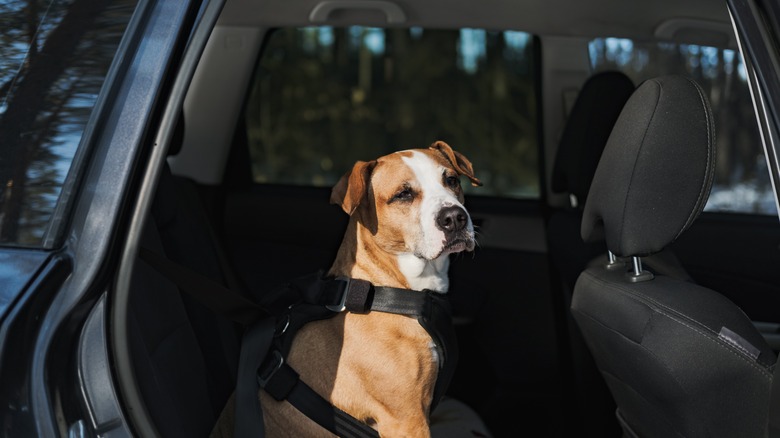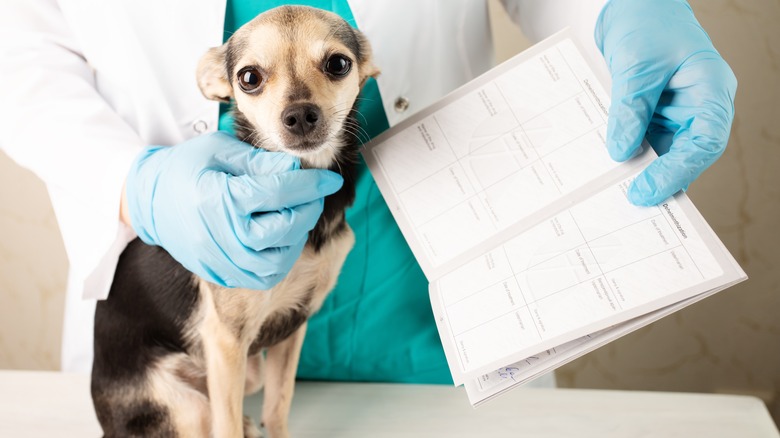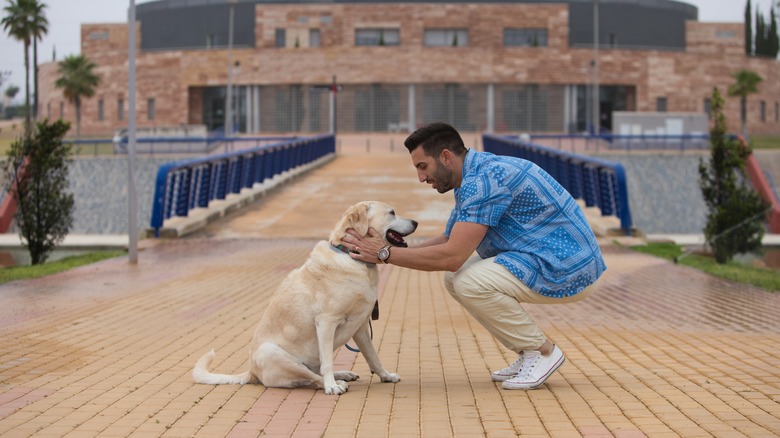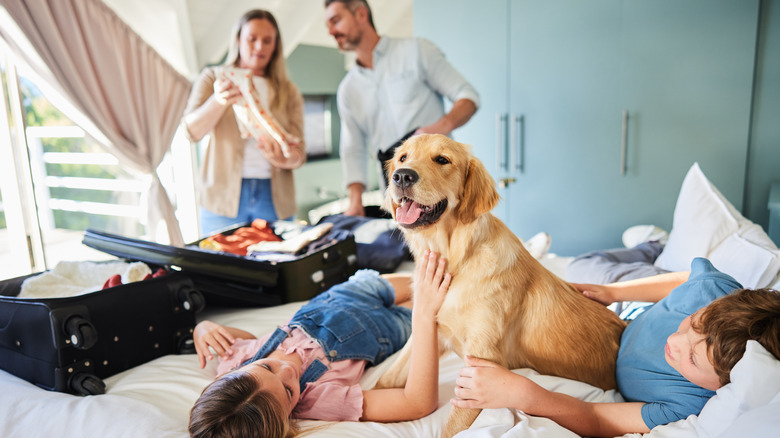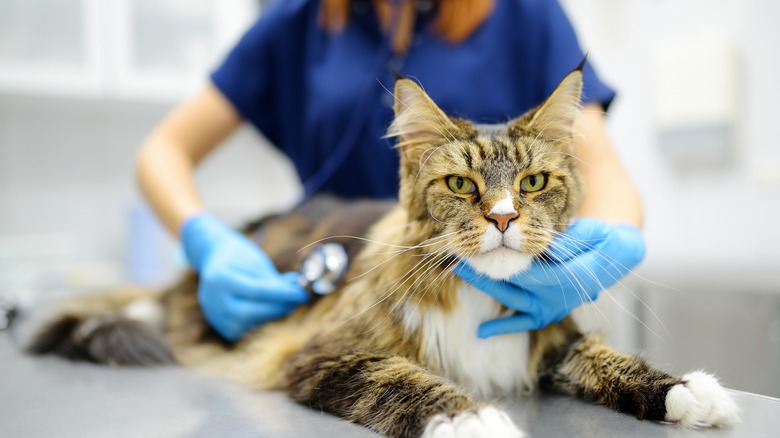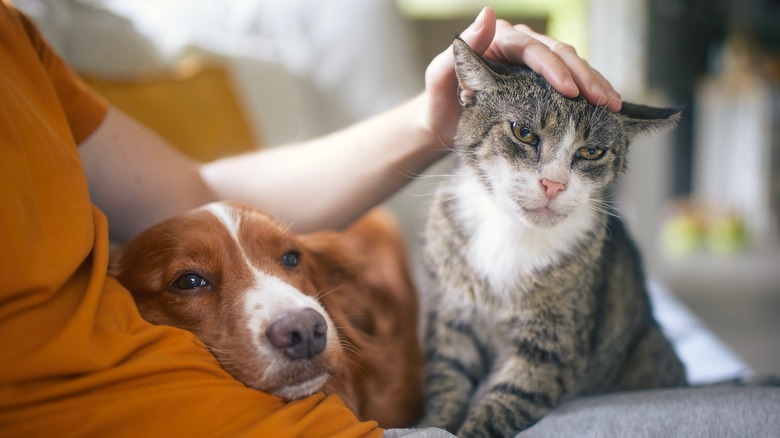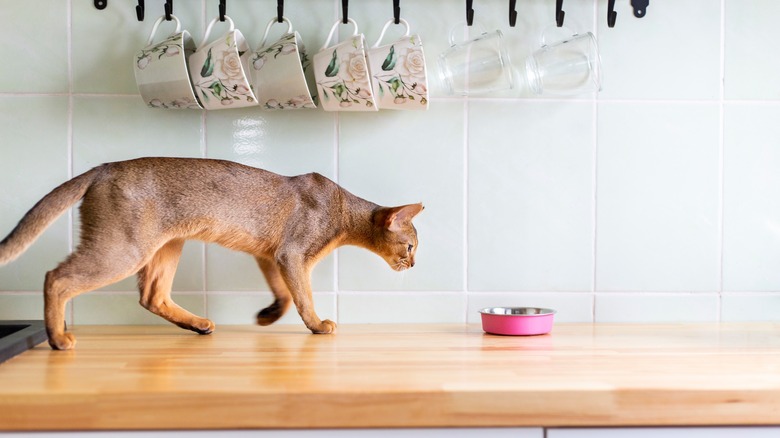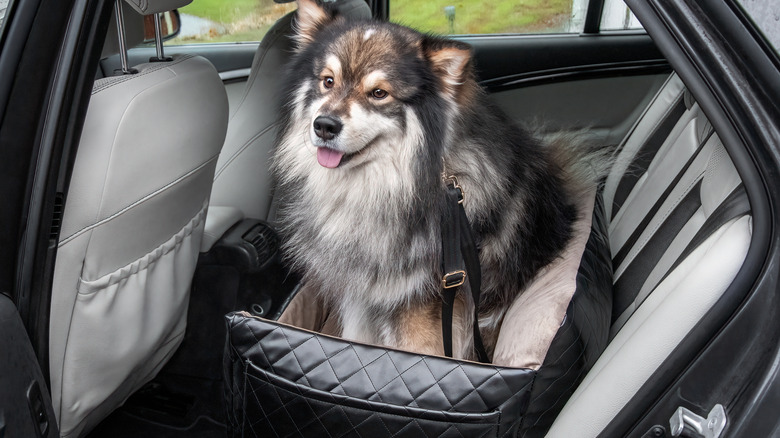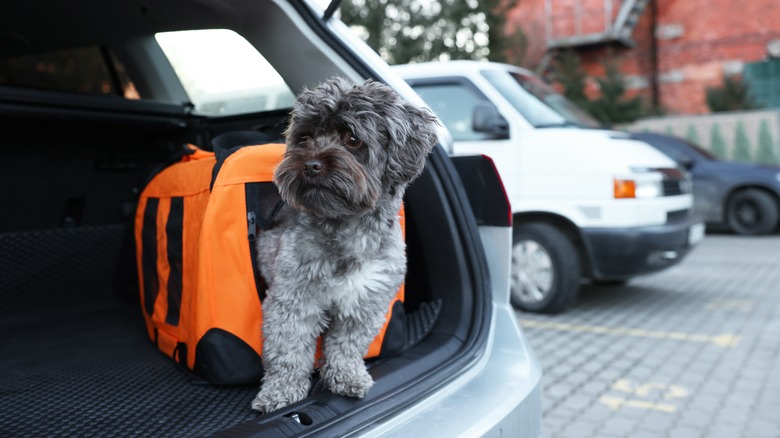The Most Common Mistakes People Make While Traveling With Pets
Anyone who has a pet will be quick to point out that their furry friend is a part of the family. So, when you travel on vacation, it's only natural to want to bring your pet along with you. After all, what's the fun of strolling along a beach, or tramping down the side of a mountain without your pet by your side? Sounds perfectly reasonable, but traveling with a pet isn't as straightforward as you might think. Bringing your pooch along requires careful planning, meticulous organization, and observing some strict rules.
In a way, it's no different from traveling with another human. In fact, some of the guidelines you need to follow, and precautions you need to take, are surprisingly similar to those for plain old humans. But some things are a little different, like the need to bring a certificate of health for travel overseas, or thinking well ahead about what you'll feed your pet. And, you should be aware of what the TSA wants you to know before flying with your pet. If you want to identify some common mistakes people make while traveling with a pet, read on.
Not booking space on a flight in time
Airlines sometimes restrict the total number of pets allowed on a flight, setting aside a certain amount of space for animals, and no more. That means, if you are set on traveling on a particular date, on a particular route, and on a specific flight, you should book well in advance to avoid disappointment. That is certainly the case if you plan to fly on one of the busiest days of the year. Cats and dogs, depending on their size, can go in the cabin with the owner, or have to fly in the cargo hold (generally for the bigger animals). There is a fee for both options, and pets usually need to be more than eight weeks old to fly.
American Airlines, for instance, stipulates a limit of seven pets in the passenger cabin on its flights, while that number drops to five for American Eagle flights. And passengers flying in first- or business-class seats can't bring pets into the cabin, due to space issues in the seat in front of them (the location where the pet, in its carrier, needs to be placed). When choosing flights, try to choose direct ones. Avoid flights in the middle of the day during summer, and the beginnings and ends of the day when it's cold outside. These won't be comfortable for the pet.
Not having the right pet carrier
While it might be more reassuring for a pet to walk around the plane, or sit in your arms during the flight, airlines don't allow it. Pets need to stay within their carrier for the entire duration of the flight. Airlines are strict with the carrier dimensions, as they have to ensure that the carrier fits under the seat in front of you. Hard or soft pet carriers for United Airlines, for example, must be between 9-11 inches in height (depending on the material of the carrier) and no wider than 12 inches. The only pets that don't have to be in a carrier while on the flight are service animals, but that requires separate paperwork to be provided.
Since your pet needs to be confined to this space for a number of hours, get them used to being in it weeks before the journey. Don't get a pet carrier that's too small for the pet or too big for the airline or the pet will be denied entry onto the flight. And be sure to label the crate with all your contact details (this is more important for a pet flying in cargo). Luggage does, as we all know, sometimes get lost, especially at New York's JFK airport. If the idea of a carrier is off-putting, look into this wholesome airline that is making skies so much friendlier for pets.
Not ensuring the pet's contact information is up to date
Not only does luggage get lost on flights, but pets also get lost on land. This is true both at home and on vacation, so it's critical to have your pet's current contact details listed at all times. This means information on their dog tags should be accurate — make sure the phone number(s) on it are right — and that they are microchipped. You can check what type of chip your dog has by using this online database run by the American Animal Hospital Association.
Once you have that, you can see which organization has registered your dog, and contact them to confirm if the address on file is up to date (you'll need the chip number to perform these tasks). Having those nuggets of information correct is crucial if your pet does disappear while you are on vacation, and you need to be contacted. Also double check that you have photos on your phone that you can print out if you need to put up "missing pet" fliers.
Not keeping pets secure in the car
Seatbelts are an intrinsic piece of safety equipment that we use when driving or flying. (Passengers might even use this seatbelt hack to help them sleep while car camping). So why don't we automatically make our pets wear one, to stop them from flying in the car during a crash? On a flight, pets are kept secure within a carrier so there isn't a whole lot of space in which they can move. But in a car, there is a higher risk of injury. Holding a pet can also be dangerous for a passenger — you can get hurt in a crash by trying to keep the pet safe by grabbing it tightly, posing a risk to your own arms.
A better option is to use harnesses that keep the animal secure. These ensure that the pet won't go bouncing around the vehicle in case of sudden changes in speed or direction. An even more secure option is to place them in a carrier or crate, either in the back seat or in the trunk space of a hatchback car. Try to avoid tethers that are long and allow the animal to walk around the back seat, since these won't stop the pet from flying around the interior in the event of a crash. If you are flying and renting a car at the destination, check with the rental company that pets are allowed in the vehicle.
Not showing that the pet has a clean bill of health
One might think that traveling within the United States doesn't require any kind of pet paperwork, but that's not strictly true. Going to California with a dog from another state? Then you need a current rabies vaccination certificate. Traveling to Hawaii is much more complex, and dogs from out of state usually have to stay in quarantine for a set number of days. For travel internationally, the authorities at the destination, and maybe U.S. border control when you return, will also want to see specific paperwork. This can include a health certificate signed by a vet that shows the dog has a current rabies vaccination, for example.
Dogs going to Canada from the U.S. need this, and this applies irrespective of whether you are traveling by car or by plane. It's important to thoroughly research the destination where you plan to travel with the pet, and carefully compile the documents needed. For Jamaica, visitors will need to have an application form, an import permit, tests and proofs of vaccinations, and sundry other forms in hand upon arrival. In addition, certain dogs like pit bull terriers and Dogo Argentinos, aren't allowed to be brought into that country.
Not taking breaks
When you see a dog curled up on the floor or on its pillow, or notice the way a cat can bend itself into impossible shapes, you might assume that they can adjust to any locale, or spot with ease. But they do need space, breaks, and the freedom to roam. Being in a car stops them from having that. You might be on a mission, wanting to power on to get to the destination, driving non-stop until you reach your final stop so as not to waste time. But dogs and cats need breaks to stretch, and relieve themselves, so you should make regular stops, even if you're pressed for time.
After taking a nap or sleeping, dogs often take a big stretch to warm themselves up again and get the joints moving. They also like to stretch when they are ready to play, so stretching is a part of a dog's daily routine. Just because they can't vocalize that they want to stretch, or go to the bathroom, it doesn't mean that they don't need to. Take a break for a few minutes every couple of hours, and let your pets sniff around a rest stop, or walk about a bit. And always make sure that fresh water is at hand, even during the ride.
Not confirming that your lodging is pet friendly
It's an easy assumption to make that you can book a room, apartment, or house, and bring your pet with you. But the reality is that not every type of accommodation is open to having pets as guests. While the awareness of, and openness to, letting pets stay has increased markedly in the past decade or two, it's still not universal. A simple way to check is to call your hotel and simply ask them if pets are allowed, and if so, what the limitations are. The American Kennel Club is a good place to start for dog owners. Its site has a page that lists hotel chains that allow pets; even if the information is a little dated, it gives a sense of what is out there.
Walt Disney World, for instance, has 22 resorts that don't allow pets, but four that do. Some hotels charge to bring a pet, some don't and there can also be limitations on the size of the animal. Airbnb has a helpful tool on its search function on the home page when looking for a place to stay. Under the "who" section that narrows down how many guests are traveling, the user can find an option that lets them add the number of pets they are bringing. The search results will use this filter to remove any properties that don't allow animals.
Not researching a vet at the destination ahead of time
A vacation is supposed to be a well-deserved break, a moment to exit daily life and whizz off for some relaxation and recharging. It's also when, as luck would have it, some of us get ill, and the same is true for pets. That's why it makes sense to research and create a list of potential vets at your destination, and to have that list handy and ready in case anything happens to your cat or dog.
Start by finding a vet that's close to where you will be staying, and then make sure they are accredited by the American Animals Hospital Association (AAHA). You can do further research on each one by looking at reviews on sites like Yelp. If you find yourself in the unfortunate position of needing emergency care for your pet, the AAHA site also features a database of reliable animal hospitals around the country.
Not keeping your pet's temperament in mind
Travel can be hard, even for those among us who are strong and healthy. For others, it can be even more draining. Now think about pets, especially those that are very old or young, or have a tendency to act out in busy public spaces. Consider also that they shouldn't necessarily travel, however much you want them to. Perhaps the thought of taking a trip without them is too painful to think about, or the heartache it would cause might be enough to ruin your trip, but sometimes you really do need to think with your head, not your heart. It can be stressful to take your cat or dog on a trip when it might struggle with the journey, and it's not really fair on them.
To be sure whether the trip is safe for your pet, check with your vet, who will be able to make a sound judgment as to the safety of such a voyage. Note that certain breeds aren't allowed to fly at all. In the case of Delta, these include Persian and Burmese cats, and Chow Chow and Boston Terrier dogs, though the list of prohibited dogs is far longer than that of cats. Short-nosed dogs like pugs, and other breeds, can die on plane flights because of their respiratory issues that are further exacerbated by variations in the air and ambient temperature onboard.
Not bringing enough food
Some of us like to try new foods when we travel — heck, some of us even travel just for the food — but pets like routine and consistency. That doesn't just apply to their daily rituals, like times for walks, naps, and meals, it goes for their food too. If you feed your pet a specific food, you must bring that food with you. After all, there is a chance, depending on where you are going, and what the food is, that you won't be able to find it at your destination. And if that happens, you might find yourself scrambling to find an alternative that your cat or dog doesn't find all that appetizing.
Calculate the number of days that you will be gone, and pack that amount, plus a little extra. Also try to keep the feeding routine the same as if you were still at home, meaning prepare the food ready to serve at the same time (wherever possible) and provide the same amount as per normal. If your pet takes medicine and will need it during the trip, be sure to pack that also. And don't forget the treats.
Not making the pet comfortable
Unless you're lucky enough to be able to spring for business- or first-class seats, a flight usually requires you to cram into a tight, confined space, and barely move at all. It's not fun, and for pets, flying is arguably worse, since they can't even get up to stretch their limbs. On a flight, there isn't much you can do to make a pet's experience less painful, but if you're traveling by car, there are ways to make the experience more enjoyable.
Try to recreate their familiar, home setting as much as possible, which means surrounding them with their favorite toys, fabrics, and blankets. You can also put them in a soft pet carrier. These will make the animal feel reassured, and less likely to become anxious during the journey. We often look at pets, how little they really need from us, and how they rarely complain and believe that they have this innate nature to adapt. In a sense, they do, but that doesn't mean that you can't help them by making any transition a little easier.
Giving them sedatives (unless your vet suggests doing so)
It's not unknown for people to take a sleeping pill or melatonin before a long flight, as a way to knock themselves out for the journey. For some travelers, it's also a method that's effective in reducing any anxiety about flying. Humans aren't the only ones who can feel nervous about traveling, and pets can be just as jittery as their owners. We can sense their discomfort — especially when they are yelping or whining — and it's only natural that we want to help ease their suffering. One obvious option is to give them a sedative, something that will calm them down and help the trip pass by without them really knowing much about it. Sounds smart, but it actually isn't and it's also potentially dangerous.
The American Veterinary Medical Association (AVMA) notes that cats or dogs that are flying, and that are sedated, can suffer from heart and breathing issues. In addition, sedation can lead to injury to the animal — if the pet carrier suddenly moves, and the pet isn't awake to adjust its body to counteract that movement, then it might get hurt while asleep. That said, the AVMA does note that there are times when tranquilizing a pet makes sense, and this is something that your vet is best equipped to decide.
Opening the carrier before you get to your accommodations
When a pet finds itself in an unfamiliar location, it can get spooked, and its first instinct might be to bolt. This, of course, is one of the worst ways to begin your vacation, so ensure that it doesn't happen. When you are waiting to pick up your car rental, for instance, or have stopped for a restroom break (for you and the pet), make sure your pet is fully leashed before you let them out of the carrier.
Don't assume that it will stick close to you, or that you can predict its behavior in new surroundings, since you can't fully comprehend what's going on inside the animal's head. They may want to explore or try to find their way home, and suddenly, before you know it, they've gotten lost. The rich array of new smells in an unfamiliar place is enough for a dog to lose track of where they're going, so it's up to you to keep your pet close by. And you can only do that if it's leashed and you are at the other end with a firm grip.
